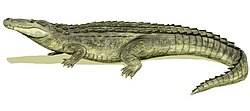References
- 1 2 Brochu, C. A.; Storrs, G. W. (2012). "A giant crocodile from the Plio-Pleistocene of Kenya, the phylogenetic relationships of Neogene African crocodylines, and the antiquity of Crocodylus in Africa". Journal of Vertebrate Paleontology. 32 (3): 587–602. Bibcode:2012JVPal..32..587B. doi:10.1080/02724634.2012.652324. S2CID 85103427.
- 1 2 Senut, B.; Pickford, M.; Ségalen, L. C. (2009). "Neogene desertification of Africa". Comptes Rendus Geoscience. 341 (8–9): 591–602. Bibcode:2009CRGeo.341..591S. doi:10.1016/j.crte.2009.03.008.
- ↑ Pickford, M. (2003). "A new species of crocodile from Early and Middle Miocene deposits of the Lower Orange River Valley, Namibia, and the origins of the Nile crocodile (Crocodylus niloticus)" (PDF). Memoirs of the Geological Survey of Namibia. 19: 51–65.
- ↑ Delfino, M.; Segid, A.; Yosief, D.; Shoshani, J.; Rook, L.; Libsekal, Y. (2004). "Fossil reptiles from the Pleistocene Homo-bearing locality of Buia (Eritrea, Northern Danakil Depression)". Rivista Italiana di Paleontologia e Stratigrafia. 110 (Suppl): 51–60. doi:10.13130/2039-4942/5764.
- ↑ Azarra, Beatrice; Boschian, Giovanni; Brochu, Christopher; Delfino, Massimo; Iurino, Dawid Adam; Kimambo, Jackson Stanley; Manzi, Giorgio; Masao, Fidelis T.; Menconero, Sofia; Njau, Jackson K; Cherin, Marco (2021). "A new cranium of Crocodylus anthropophagus from Olduvai Gorge, northern Tanzania". Rivista Italiana di Paleontologia e Stratigrafia (Research in Paleontology and Stratigraphy). 127 (2): 275–295. doi:10.13130/2039-4942/15771.


